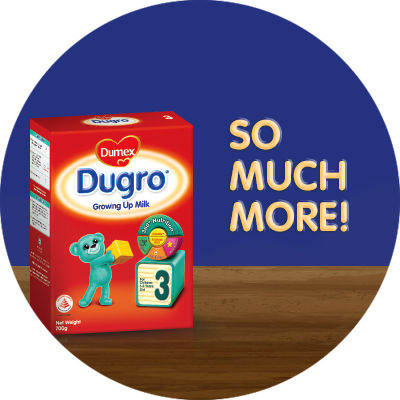Breastfeeding is the best for babies and a healthy diet / maternal nutrition is important when breastfeeding. A decision not to breastfeed can be difficult to reverse. Infant formula is suitable from birth when babies are not breastfed. It is recommended that all formula milks be used on the advice of a doctor, midwife, health visitor, public health nurse, dietitian, pharmacist, or other professional responsible for maternal and child care and the financial implications should be considered. All preparation and feeding instructions should be followed carefully as inappropriate preparation could lead to health hazards.
Top 3 Considerations When Choosing Milk Formula
For many parents, making decisions for the well-being of their child is a nerve-wracking process, but among the decisions you will have to make on behalf of your child, few come close to being as stressful as looking for the best milk formula for your little one. What nutrients are essential, what should and should not be in the ingredient list, will the milk formula you have in mind be friendly on the wallet but still - you’ve done all the required research and asked around for recommendations from fellow mums but still find yourself on the fence about what milk formula to buy. So, what should you be looking for in a milk formula? Here are the top 3 factors to take into consideration when deciding what milk formula is best for juniors.
DHA & Brain Development
The brain is undoubtedly one of the most important organs in our bodies and its proper development is essential for your child’s healthy growth.1 A child’s brain undergoes rapid development and growth during their early childhood, particularly from the 12th month onwards, resulting in your little one’s acquisition of skills such as talking and motor skills.2 3 Healthy brain development largely depends on the right care and nutrition, hence a milk formula with nutrients such as DHA will help to promote optimal development of your child’s brain.1 4
How can DHA promote the healthy development of your child’s brain? DHA, known scientifically as docosahexaenoic acid, is an essential omega-3 fatty acid often found in abundance in fatty fish and it’s also present in lower levels in meat and eggs.4 In general, DHA and omega-3s are important components that make up the membranes surrounding each cell in our bodies with DHA levels being particularly concentrated in the eye, skin and brain cells. DHA levels are higher in the cell membranes where it makes the membranes and the gaps between cells more fluid to enable nerve cells to send and receive electrical signals.5 DHA is especially important for brain tissue growth during development.6 This is because your child’s frontal lobes are dependent on it during development as this part of the brain is responsible for processing information, sustaining attention spans, planning, problem-solving and social, emotional and behavioural development.7
A lack of DHA also results in poorer eyesight and slower brain function, hence it is important that your child receives enough DHA in his/her diet to develop a healthy brain.7 When choosing a milk formula, it’s best to look for DHA such as the fish oil used in our new Dumex Mamil Gold formulation.
Immunity
Studies have proven that children who are not getting the right balance of nutrition often suffer from poor immunity, falling sick more often and disrupting their growth. 9 Even micronutrient deficiencies can result in adverse effects such as poor growth, impaired intellect and a higher risk of infection.10 With the emergence of new illnesses, having a strong immune system is more important than ever. Strengthening the immune system should begin from a young age to prevent illnesses from disrupting your child’s life, growth and development. The milk formula you choose for your child plays an important aspect in delivering the required essential nutrients. Studies have shown that children who consumed formulated milk powder containing a specific blend of prebiotics galacto-oligosaccharides (GOS) and long chain fructo-oligosaccharides (lcFOS) with polyunsaturated fatty acids are at lower risk of developing infections. 11
A good milk formula should also contain other essential nutrients such as vitamin D, iron and zinc as a lack of these micronutrients can have negative effects on your child’s overall health and immunity.9 12 Vitamin D is critical for building healthy bones, optimal muscle and nerve functions and increasing your child’s immune system’s ability to resist bacteria and viruses.13 Iron is a critical nutrient for motor and cognitive development in addition to preventing anaemia while zinc helps support a healthy immune system and decreases the risk of childhood diarrhea. 14 15 16
No harmful ingredients
Nobody wants harmful ingredients in their food, much less in their little one’s milk formula. While artificial colouring are bad for adults, they tend to only show obvious side effects if consumed in large amounts, but the same cannot be said for children.19 Artificial colouring have no nutritional value and may actually be hazardous to your child’s health as a child’s metabolic systems are still developing and therefore vulnerable. 20 21
Artificial food colouring has also been linked to behavioural issues in some children, with children who have an existing diagnosis of ADHD or hyperactivity being particularly susceptible. 21 It has also been linked to increased risk of stomach upsets, irritability and sleep issues in children. 21
At Dumex, we understand the struggle of finding the right milk formula for your child which is why we hold firm to our mission of delivering only the best to you and your child. Dumex Mamil Gold range is made with a formulation that contains no GMOs, colouring or added sucrose. Our Dumex Mamil Gold Growing up milk formulation presents your child with the wholesome goodness of grass-fed milk containing a unique prebiotics blend that helps to maintain a healthy digestive system, vitamin D and E, calcium, zinc, omega-3 and 6 as well as DHA from fish oils for brain development (as high as 75mg per 100g) for Stage 3. The new Dumex Mamil Gold formula uses a unique combination of galacto-oligosaccharides, long chain fructo-oligosaccharides and a long list of essential nutrients to keep your little one’s tummy happy and healthy while supporting healthy bone growth and brain development because at Dumex, we believe a healthy child results in a happy mama too.
Unsure if your little one will take to it or interested in starting your kiddo on the new Dumex Mamil Gold range? Visit Dumex.com.sg for samples now and explore the various benefits that your child can get from Dumex Mamil Gold!
References
1. Childhood Development: Early Brain Development. (2020). Retrieved April 19, 2020 from https://www.cdc.gov/ncbddd/childdevelopment/early-brain-development.html
2. Robinson, L.R., Bitsko, R.H., Thompson, R.A., Dworkin, P.H., McCabe, M.A., Peacock, G and Thorpe, P.G. (2017). CDC Grand Rounds: Addressing Health Disparities in Early Childhood. Retrieved from https://www.cdc.gov/mmwr/volumes/66/wr/mm6629a1.htm
3. Speech and Language Development: 12 to 24 months. (2017). Retrieved April 19, 2020, from https://www.chkd.org/Patients-and-Families/Health-Library/Way-to-Grow/Speech-and-Language-Development---12-to-24-months/
4. Omega-3 Fatty Acids (2019). Retrieved April 19, 2020, from https://ods.od.nih.gov/factsheets/Omega3FattyAcids-Consumer/
5. Stillwell, W. and Wassall SR. (2003). Docosahexaenoic acid: membrane properties of a unique fatty acid. PubMed.gov. Retrieved from https://www.ncbi.nlm.nih.gov/pubmed/14580707
6. Horrocks, LA. and Yeo, YK. (1999). Health benefits of docosahexaenoic acid (DHA). PubMed.gov. Retrieved from https://www.ncbi.nlm.nih.gov/pubmed/10479465
7. Bjarnadottir, A. (2019). DHA (Docosahexaenoic Acid): A Detailed Review. Healthline.com. Retrieved from https://www.healthline.com/nutrition/dha-docosahexaenoic-acid#sources
8. Huff, E. (2009). Synthetic DHA and ARA in Baby Formula is Causing Infant Illness. NaturalNews.com. Retrieved from https://www.naturalnews.com/027437_DHA_baby_formula.html#ixzz3OCE7ur2i
9. Chandra, R.K. (1997). Nutrition and the immune system: an introduction. Retrieved from https://www.ncbi.nlm.nih.gov/pubmed/9250133
10. Katona, P. and Katona-Apte, J. (2008). The Interaction between Nutrition and Infection. Retrieved from https://academic.oup.com/cid/article/46/10/1582/294025
11. Chatchatee P et al. (2014). Effects of Growing-Up Milk Supplemented with Prebiotics and LCPUFAs on Infections in Young Children. JPGN 2014; 58(4):428-437
12. Nutrition: Micronutrient Facts. (2020). Centers for Disease Control and Prevention. Retrieved April 19, 2020 from https://www.cdc.gov/nutrition/micronutrient-malnutrition/micronutrients/index.html
13. Vitamin D Fact Sheet for Consumers. (2020). National Institutes of Health Office of Dietary Supplements. Retrieved April 19, 2020 from https://ods.od.nih.gov/factsheets/VitaminD-Consumer/
14. Stevens, G.A., Finucane, M.M., De-Regil, L.M., Paciorek, C.J., Flaxman, S.R., Branca, F., Peña-Rosas, J.P., Bhutta, Z.A., and Ezzati, M. (2013). Global, regional, and national trends in haemoglobin concentration and prevalence of total and severe anaemia in children and pregnant and non-pregnant women for 1995–2011: a systematic analysis of population-representative data. Retrieved from https://www.thelancet.com/pdfs/journals/langlo/PIIS2214-109X(13)70001-9.pdf
15. Ackland, M.L. and Michalczyk A.A. (2016). Zinc and infant nutrition. Retrieved from https://www.ncbi.nlm.nih.gov/pubmed/27317042
16. Wessells, K.R. and Brown, K.H. (2012). Estimating the Global Prevalence of Zinc Deficiency: Results Based on Zinc Availability in National Food Supplies and the Prevalence of Stunting. Retrieved from https://www.ncbi.nlm.nih.gov/pmc/articles/PMC3510072/
17. Are Artificial Food Flavors and Colorings Harmful? (2018). News Medical Life Sciences. Retrieved April 20, 2020 https://www.news-medical.net/health/Are-Artificial-Food-Flavors-and-Colorings-Harmful.aspx
18. Sharma, S. (2015) .Food preservatives and their harmful effects. Retrieved from: http://www.ijsrp.org/research-paper-0415/ijsrp-p4014.pdf
19. Trasanade, L., Shaffer, R.M., Sathyanarayana, S. and Council on Environmental Health. (2018). Food Additives and Child Health. Pediatrics, Official Journal Of The American Academy Of Pediatrics. Retrieved from https://pediatrics.aappublications.org/content/142/2/e20181408
20. Huber, J. (2015). 9 things parents should know about food dyes. Today’s Parent. Retrieved from https://www.todaysparent.com/family/family-health/food-dyes/
21. Food Additives: What Parents Should Know. (2018). Healthy Children.org. Retrieved April 20, 2020 from https://www.healthychildren.org/English/healthy-living/nutrition/Pages/Food-Additives.aspx


Ask Our Careline
Whatever’s on your mind, we’re here to help




